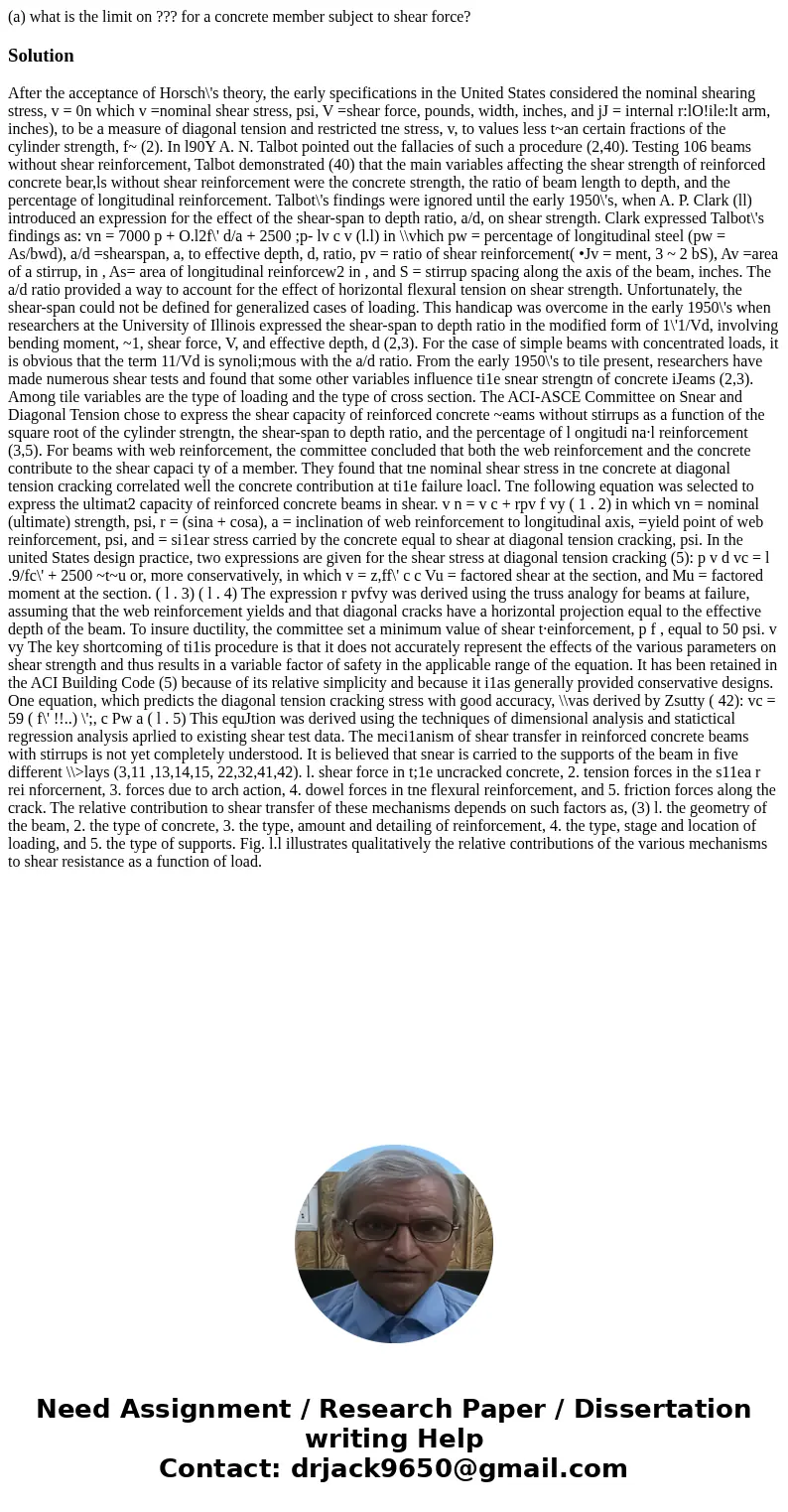a what is the limit on for a concrete member subject to she
Solution
After the acceptance of Horsch\'s theory, the early specifications in the United States considered the nominal shearing stress, v = 0n which v =nominal shear stress, psi, V =shear force, pounds, width, inches, and jJ = internal r:lO!ile:lt arm, inches), to be a measure of diagonal tension and restricted tne stress, v, to values less t~an certain fractions of the cylinder strength, f~ (2). In l90Y A. N. Talbot pointed out the fallacies of such a procedure (2,40). Testing 106 beams without shear reinforcement, Talbot demonstrated (40) that the main variables affecting the shear strength of reinforced concrete bear,ls without shear reinforcement were the concrete strength, the ratio of beam length to depth, and the percentage of longitudinal reinforcement. Talbot\'s findings were ignored until the early 1950\'s, when A. P. Clark (ll) introduced an expression for the effect of the shear-span to depth ratio, a/d, on shear strength. Clark expressed Talbot\'s findings as: vn = 7000 p + O.l2f\' d/a + 2500 ;p- lv c v (l.l) in \\vhich pw = percentage of longitudinal steel (pw = As/bwd), a/d =shearspan, a, to effective depth, d, ratio, pv = ratio of shear reinforcement( •Jv = ment, 3 ~ 2 bS), Av =area of a stirrup, in , As= area of longitudinal reinforcew2 in , and S = stirrup spacing along the axis of the beam, inches. The a/d ratio provided a way to account for the effect of horizontal flexural tension on shear strength. Unfortunately, the shear-span could not be defined for generalized cases of loading. This handicap was overcome in the early 1950\'s when researchers at the University of Illinois expressed the shear-span to depth ratio in the modified form of 1\'1/Vd, involving bending moment, ~1, shear force, V, and effective depth, d (2,3). For the case of simple beams with concentrated loads, it is obvious that the term 11/Vd is synoli;mous with the a/d ratio. From the early 1950\'s to tile present, researchers have made numerous shear tests and found that some other variables influence ti1e snear strengtn of concrete iJeams (2,3). Among tile variables are the type of loading and the type of cross section. The ACI-ASCE Committee on Snear and Diagonal Tension chose to express the shear capacity of reinforced concrete ~eams without stirrups as a function of the square root of the cylinder strengtn, the shear-span to depth ratio, and the percentage of l ongitudi na·l reinforcement (3,5). For beams with web reinforcement, the committee concluded that both the web reinforcement and the concrete contribute to the shear capaci ty of a member. They found that tne nominal shear stress in tne concrete at diagonal tension cracking correlated well the concrete contribution at ti1e failure loacl. Tne following equation was selected to express the ultimat2 capacity of reinforced concrete beams in shear. v n = v c + rpv f vy ( 1 . 2) in which vn = nominal (ultimate) strength, psi, r = (sina + cosa), a = inclination of web reinforcement to longitudinal axis, =yield point of web reinforcement, psi, and = si1ear stress carried by the concrete equal to shear at diagonal tension cracking, psi. In the united States design practice, two expressions are given for the shear stress at diagonal tension cracking (5): p v d vc = l .9/fc\' + 2500 ~t~u or, more conservatively, in which v = z,ff\' c c Vu = factored shear at the section, and Mu = factored moment at the section. ( l . 3) ( l . 4) The expression r pvfvy was derived using the truss analogy for beams at failure, assuming that the web reinforcement yields and that diagonal cracks have a horizontal projection equal to the effective depth of the beam. To insure ductility, the committee set a minimum value of shear t·einforcement, p f , equal to 50 psi. v vy The key shortcoming of ti1is procedure is that it does not accurately represent the effects of the various parameters on shear strength and thus results in a variable factor of safety in the applicable range of the equation. It has been retained in the ACI Building Code (5) because of its relative simplicity and because it i1as generally provided conservative designs. One equation, which predicts the diagonal tension cracking stress with good accuracy, \\vas derived by Zsutty ( 42): vc = 59 ( f\' !!..) \';, c Pw a ( l . 5) This equJtion was derived using the techniques of dimensional analysis and statictical regression analysis aprlied to existing shear test data. The meci1anism of shear transfer in reinforced concrete beams with stirrups is not yet completely understood. It is believed that snear is carried to the supports of the beam in five different \\>lays (3,11 ,13,14,15, 22,32,41,42). l. shear force in t;1e uncracked concrete, 2. tension forces in the s11ea r rei nforcernent, 3. forces due to arch action, 4. dowel forces in tne flexural reinforcement, and 5. friction forces along the crack. The relative contribution to shear transfer of these mechanisms depends on such factors as, (3) l. the geometry of the beam, 2. the type of concrete, 3. the type, amount and detailing of reinforcement, 4. the type, stage and location of loading, and 5. the type of supports. Fig. l.l illustrates qualitatively the relative contributions of the various mechanisms to shear resistance as a function of load.

 Homework Sourse
Homework Sourse